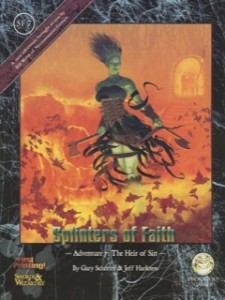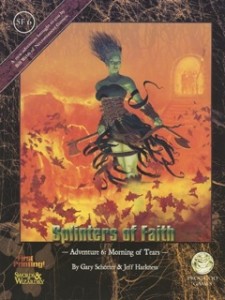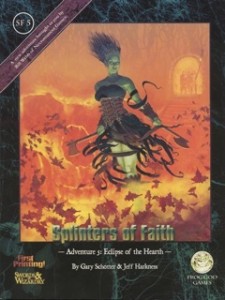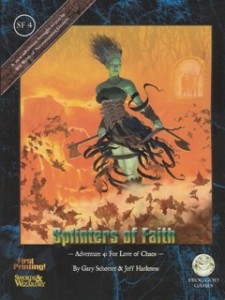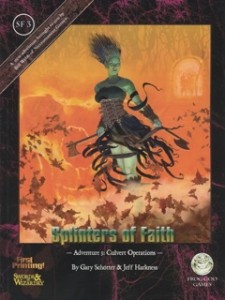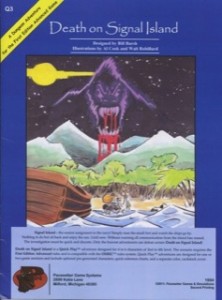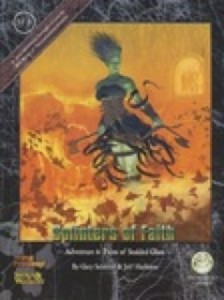 This is the eighth adventure on the Frog God Games Splinters of Faith adventure path. Each module has a adventure that can serve as a stand-alone location or link together through the entire ten part series in order to destroy a resurrected vampire lord. In each module a good temple is described, which serves as the hook for the adventure path. Inevitably the good temple needs the party to fetch something for them before they can/will perform the blessing required for the adventure path. This involves the party traveling to an evil temple.
This is the eighth adventure on the Frog God Games Splinters of Faith adventure path. Each module has a adventure that can serve as a stand-alone location or link together through the entire ten part series in order to destroy a resurrected vampire lord. In each module a good temple is described, which serves as the hook for the adventure path. Inevitably the good temple needs the party to fetch something for them before they can/will perform the blessing required for the adventure path. This involves the party traveling to an evil temple.
In this module the good temple is devoted to the Lady of the Scalding Waters and is located in the caldera of a volcano. It’s a ‘fantastic’ temple, in that it’s located in a geyser field and is in the shape of a lotus, with a geyser located in the center of the temple, complete with glass-enclosed viewing chamber. The temple is briefly described, and has the beginnings of an interesting plot, with a couple of ‘factions’ involved in the temple; a group of corrupted priests are hinted at along with at least one who is outright evil. The town nearby, hanging over the edge of caldera, is briefly described, along with a couple of faction descriptions in the town. Again, the chief of which are a couple of evil priests. While the temple and town setting could be described as ‘fantastic’, the settings are lacking a bit on the interesting detail which would really bring the setting alive. We do get a page describing an NPC Druid class of the evil god featured, which is a nice addition, especially in a Swords & Wizardry product.
What the good temple lacks is made up for in the evil temple/adventure section. Our baddies have located themselves in the depths of a mine. THAT’s not all that interesting, but just about everything else is. The evil priests worship an insect god, so we get lots and lots of vermin which I LOVE in an adventure. In addition the mine maps are full of looping passages and alternate paths to get the locations. This is the sign of a good dungeon since it’s doesn’t railroad the party in to encounters. Finally, the mines have A LOT of factions in it. This is what turns it from a decent adventure in to something stellar. Almost ever single intelligent creature encounter could conceivable we worked through with talking & negotiation. This is WONDERFUL; creatures with their own motivations and reasons for being in the dungeon. Spies, the disillusioned guards, previous occupants, new occupants from deeper levels; almost every intelligent creature has a good reason for being there other than ‘Im a fanatical cultist.’ In fact, some of the factions have factions also!
I was hooked pretty early in to the dungeon, during the introduction. Here’s the brief summary that sealed the deal: “Phyllox (the EHP) is now facing trouble on many fronts: a retriever wandering the mines, a dergogaemon that refuses to return to the lower plans and also refuses to fight, a bugbear rebellion and an aboleth invasion. Phyllox’s dream of a grand temple to Rachiss is quickly falling apart.” And that’s not the HALF of it. He’s got a host of other problems that he doesn’t yet know about. In to this mess drops the PC’s. There’s a real sense that the party is entering a living breathing environment with it’s own events & issues going on, not just waiting for the next band of adventurers to slaughter them. There have been shades of this sort of thing in other modules and especially in the wandering monster tables; the wanderers are listed with a reason for being there and wandering about. None of the previous modules in the this series has gone this far, and I can’t recall ANY other module, OSR, TSR or otherwise, that has had this much, not TOEE and not the Steading, which has been the gold standard against which I’ve held up my factions yardstick in the past. This place is ALIVE, and the PC’s just walked right in. Our fearless DM’s may have problems getting the party to realize they don’t need to hack everything in sight, especially since the factions have been a little light in the past, but that’s what the DM is for; getting the players involved. What all of this means is that there’s a lot of different ways for the party to accomplish their goal, and that makes this module GREAT. There’s vermin & ooze, new monsters and new magic items, environmental issues, The adventure is just about perfect. I prefer to have more tricks and a few more traps, although I suspect that’s just a quibble.
It does have one VERY bad feature, which is listed as optional but which I’d lie to highlight. During a certain fight it’s noted that the DM can make the fight tougher by suddenly introducing the creatures opposed faction, from elsewhere in the dungeon. That’s kind of cheap. What’s worse is that it advises that if the party has already killed that faction, then an Demon Price senses it and send a replacement to be involved in the fight in the same way. That, gentle readers, is a CHEAP SHOT. If the party has wasted resources taking out the previous encounter then why punish them by, in essence, making their actions irrelevant? For the sake of story & plot? That’s BS. Let the players create their own story. In any event, it’s offered as an option in a sidebar, so it’s not too intrusive. It’s also one of the first things of this type I’ve seen in this series, which is probably why it stood out so much.
The dungeon portion of this is a fabulous adventure and with a little work the scalded & burnt priests in the good temple could be turned in to a decent home-base type locale. It’s my favorite adventure in the series so far.
This is $5 at DriveThru.

